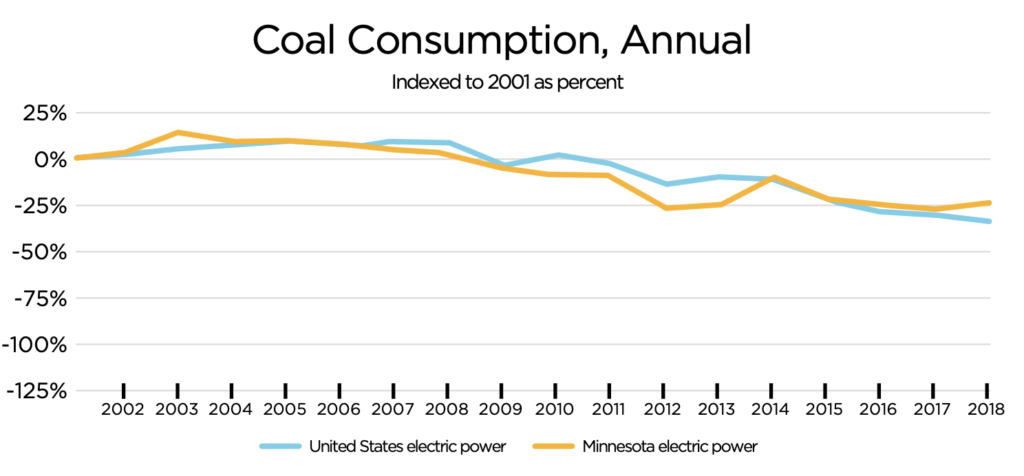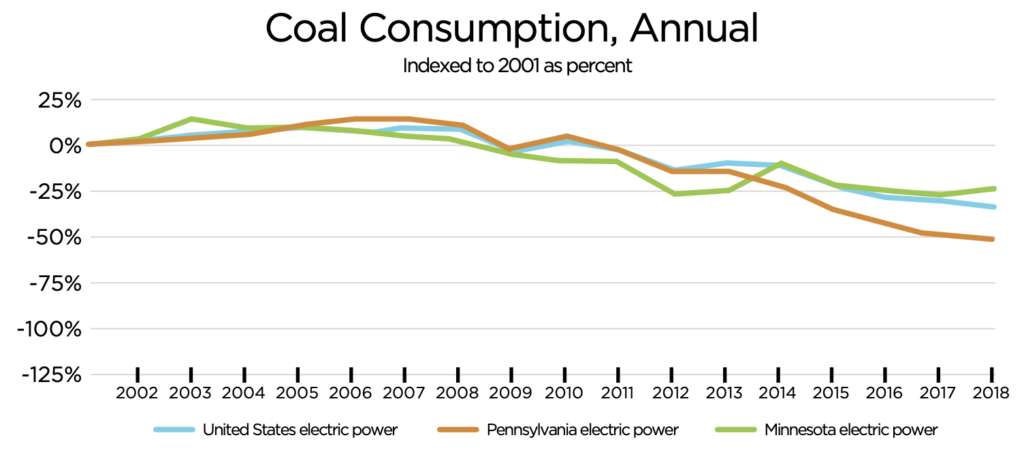Shades of green
Minnesota is slow to quit coal, despite surging prices for electricity.
Data from the U.S. Energy Information Administration (EIA) goes a long way to debunk the myth that Minnesota is a “green” state. The EIA shows that from 2001 to 2018, the state has reduced its coal consumption slower than the nation as a whole and by a smaller margin, but its electricity prices have increased far faster than the national average.
In essence, Minnesota’s energy policy has been a massively expensive failure, and proposals to shut down the remainder of the state’s coal plants and replace them with wind, solar, and natural gas will cause electricity prices to skyrocket even more.
The nearby graph from the EIA shows that Minnesota has reduced its coal consumption by 25 percent since 2001—nine percent slower than the nation as a whole.
Despite this, Minnesota’s electricity prices have increased much faster than the national average. EIA data show massive increases in electricity prices in Minnesota since 2007, when then-Governor Tim Pawlenty signed the Next Generation Energy Act (NGEA) into law, which mandated that renewable energy sources generate 25 percent of Minnesota’s electricity by 2025.
Before the NGEA, Minnesota lawmakers required Xcel Energy to build wind turbines as part of a 2005 deal to continue operating the electric services company’s fleet of nuclear power plants. Since that time, our electricity prices have increased almost twice as much as the national average.
This means Minnesota families and businesses have seen their electricity prices increase much faster than the national average for results that have been significantly worse, to date.
Other states have reduced their coal consumption by developing low-cost natural gas. For example, thanks to hydraulic fracturing, Pennsylvania became the second-largest natural gas producing state in the country. Its coal consumption reduced by 50 percent—double the rate of the coal reduction we’ve seen in Minnesota.
Not only has Pennsylvania doubled Minnesota’s reduction in coal consumption, the Keystone State has done so at a fraction of the cost. Since 2005, Pennsylvania has seen its electricity prices increase by only 18.5 percent, which is 41.4 percent less than the price hikes we’ve seen in Minnesota.
Minnesotans have watched their electricity prices surge because politicians and utility companies want to replace reliable, affordable coal-fired power plants with weather-dependent resources like wind and solar, which will require billions of dollars of expensive transmission lines to accommodate, as well as large quantities of natural gas fired electricity.



What’s to come in the future?
Renewable energy advocates will argue that Minnesota’s future coal reductions will be above average when Xcel Energy enacts its plan to prematurely retire its coal-fired power plants over the next decade. This claim will likely be true if Xcel is allowed to shut down these affordable, reliable sources of electricity, but it will come at a great cost.
American Experiment’s Mitch Rolling recently wrote an article explaining that Xcel’s plan to shutter its coal plants and replace them with a combination of wind, solar, and natural gas will cost its customers $46 billion through 2050 and cause electricity prices to rise by about 30 percent relative to today’s prices. This means the average Xcel Energy customer in Minnesota will pay nearly $1,200 in additional costs per year, every year through 2050. And the enormous costs associated with Xcel’s plan would avert just 0.0003 degrees Celsius of future global warming by 2100—an amount far too small to measure.
Minnesota’s rush to renewables has resulted in skyrocketing electricity prices for lackluster results. Repeating this mistake will continue to harm Minnesota families and businesses by making it more expensive to keep the lights on.
Instead of closing down our coal-fired power plants before the end of their useful lifetimes, Minnesota utilities should continue to use these affordable, reliable plants until it no longer makes economic sense to keep repairing them. Then, transitioning to reliable, low carbon sources of electricity such as nuclear and hydro power will yield the greatest reduction in carbon dioxide for the lowest cost.